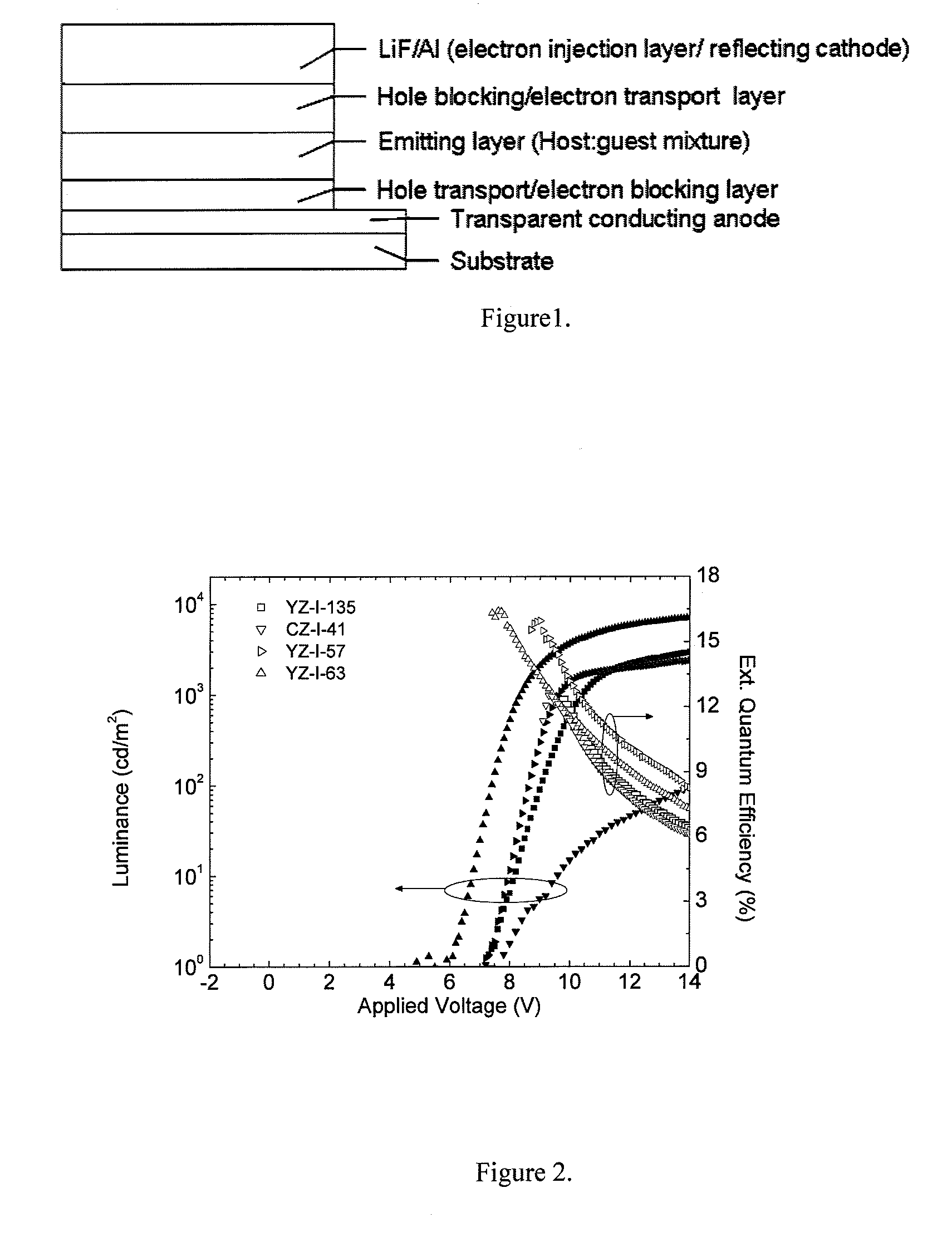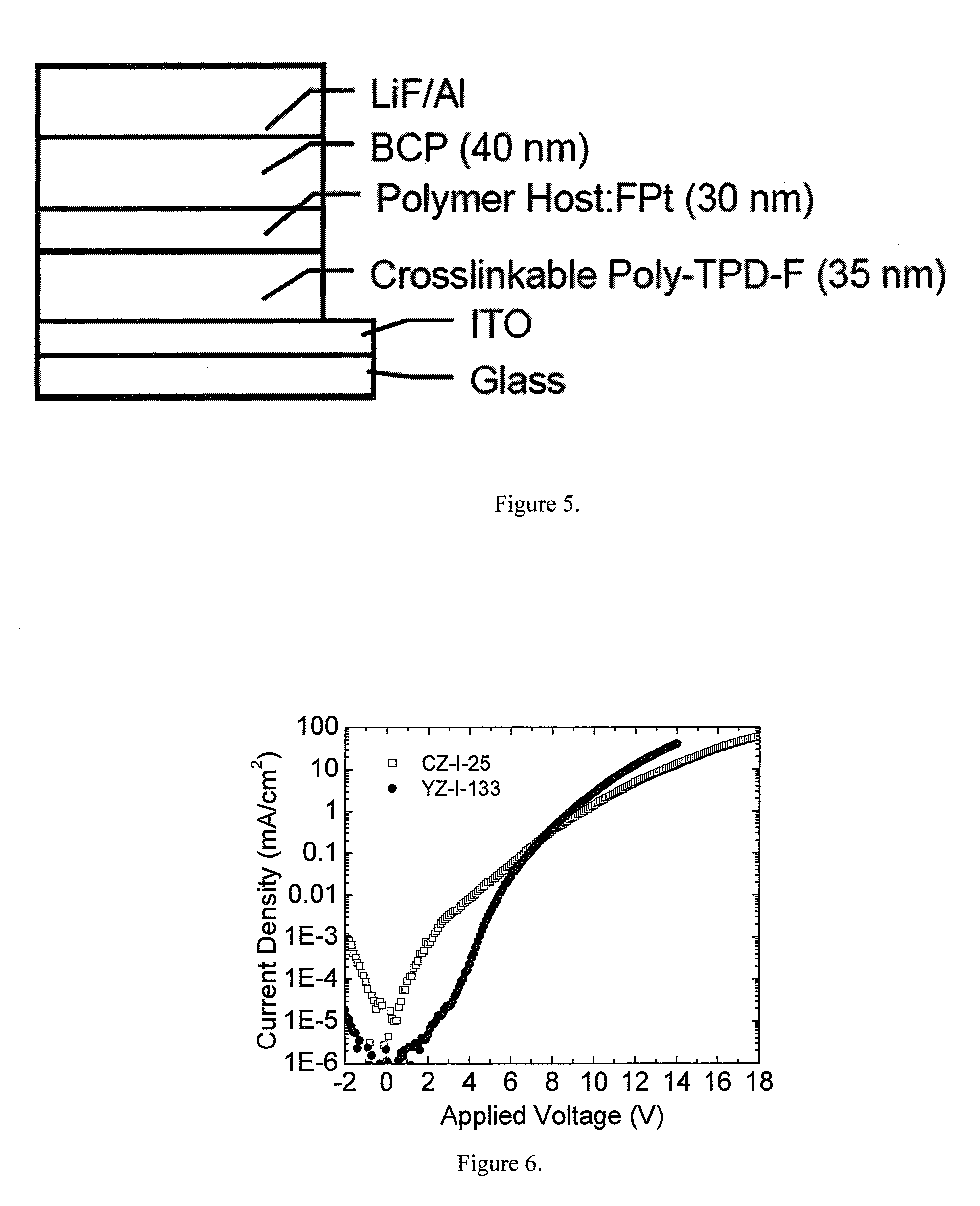Carbazole-based hole transport and/or electron blocking materials and/or host polymer materials
- Summary
- Abstract
- Description
- Claims
- Application Information
AI Technical Summary
Benefits of technology
Problems solved by technology
Method used
Image
Examples
example 1
Preparative Example 1
Synthesis of -3,6-di-tert-butylcarbazole (YZ-I-1)
[0100]
[0101]To a solution of carbazole (6.6 g, 39.5 mmol) and zinc (II) chloride (16.2 g, 118.8 mmol) in nitromethane (100.0 ml) was added dropwise 2-chloro-2-methylpropane (11.1 g, 120.0 mmol) under nitrogen atmosphere and stirring. The addition of 2-chloro-2-methylpropane was carried out over a 15 minute period. The mixture was stirred at room temperature for 24 hours. Water (100.0 ml) was then added. The product was extracted with dichloromethane (3×60.0 ml). The organic layer was washed with water (3×100.0 ml), and then dried with MgSO4, and dichloromethane was evaporated under vacuum. The product was purified by recrystallization from hot hexane to afford a white product crystal in the amount of 5.0 g (in 45.0% yield).
[0102]1H NMR (CDCl3): δ 8.06 (d, 2HCz, J=1.6 Hz), 7.83 (s, br, 1H, NH), 7.45 (dd, 2HCz, J1=8.8 Hz, J2=1.6 Hz), 7.30 (d, 2HCz, J=8.8 Hz), 1.45 (s, 18H, 9×CH3). 13C NMR (CDCl3): δ 142.04, 137.84, ...
example 2
Preparative Example 2
Synthesis of 3,6-di-tert-butyl-9-(2-hydroxy ethyl) carbazole (YZ-I-69)
[0103]
[0104]To a solution of 9-(2-hydroxy ethyl)carbazole (1.65 g, 7.81 mmol) in 2-chloro-2-methylpropane (25.0 ml) was added aluminum trichloride (0.54 g, 4.05 mmol) at room temperature under nitrogen atmosphere and stirring. After 1 minute, the addition of AlCl3, insoluble 9-(2-hydroxyethyl)carbazole disappeared. The reaction was carried out at room temperature for 25 minutes, and water (20.0 ml) was added. The product was extracted with ethyl acetate (3×20.0 ml). The organic layer was washed with water (3×60.0 ml), and then ethyl acetate was evaporated under vacuum. The product was applied to a silica gel column [ethyl acetate / hexanes (3.5:6.5)] to yield 2.1 g (84.0%) of a white solid after recrystallization from dichloromethane / hexanes.
[0105]1H NMR (CDCl3): δ 8.09 (d, 2HCz, J=2.4 Hz), 7.50 (dd, 2HCz, J1=8.4 Hz, J2=2.4 Hz), 7.35 (d, 2HCz, J=8.4 Hz), 4.42 (t, 2H, OCH2, J=5.6 Hz), 4.03 (t, 2H...
example 3
Preparative Example 3
Synthesis of 1,3-Bis(3,6-di-tert-butylcarbazol-9-yl)benzene (YZ-I-73)
[0106]
[0107]To a solution of 1,3-di(carbazol-9-yl)benzene (1.0 g, 2.45 mmol) in 2-chloro-2-methylpropane (10.0 ml) was added aluminum trichloride (0.32 g, 2.40 mmol) at room temperature under nitrogen atmosphere and stirring. After the addition of AlCl3, insoluble 1,3-di(carbazol-9-yl)benzene disappeared within minutes. The green solid appeared after 5 minutes of reacting at room temperature. The reaction was carried out at room temperature for another 10 minutes. TLC showed that the reaction was finished. After which, water (20.0 ml) was added and the green solid became white. The solid product was collected with filtration and washed with methanol. The product was purified by recrystallization from acetone / THF / methanol to yield a white solid in the amount of 1.23 g (79.4%).
[0108]1H NMR (CDCl3): δ 8.13 (s, 4HCz), 7.77 (m, 2H, HBz), 7.63 (dd, 2HBz, J1=8.0 Hz, J2=2.0 Hz), 7.50 (m, 8HCz), 1.45 (s...
PUM
| Property | Measurement | Unit |
|---|---|---|
| Structure | aaaaa | aaaaa |
| Transport properties | aaaaa | aaaaa |
| Processability | aaaaa | aaaaa |
Abstract
Description
Claims
Application Information
 Login to View More
Login to View More - R&D
- Intellectual Property
- Life Sciences
- Materials
- Tech Scout
- Unparalleled Data Quality
- Higher Quality Content
- 60% Fewer Hallucinations
Browse by: Latest US Patents, China's latest patents, Technical Efficacy Thesaurus, Application Domain, Technology Topic, Popular Technical Reports.
© 2025 PatSnap. All rights reserved.Legal|Privacy policy|Modern Slavery Act Transparency Statement|Sitemap|About US| Contact US: help@patsnap.com



